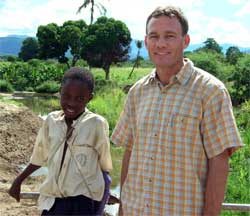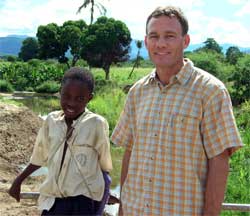 NARRAGANSETT, R.I. – June 4, 2007 – Population growth and poverty in the East African country of Tanzania have increased demand on the Wami-Ruvu and Pangani River watersheds and placed the health of Saadani National Park at risk. To help the Tanzanian government manage these issues, the University of Rhode Island’s Coastal Resources Center (CRC) was recently awarded a four-year, $800,000 grant from the U.S. Agency for International Development and The Coca-Cola Company.
NARRAGANSETT, R.I. – June 4, 2007 – Population growth and poverty in the East African country of Tanzania have increased demand on the Wami-Ruvu and Pangani River watersheds and placed the health of Saadani National Park at risk. To help the Tanzanian government manage these issues, the University of Rhode Island’s Coastal Resources Center (CRC) was recently awarded a four-year, $800,000 grant from the U.S. Agency for International Development and The Coca-Cola Company.
The grant is part of the Tanzania Water and Development Alliance, which aims to strengthen government efforts to promote sustainable management of water and watershed resources in the river basins, improve community access to safe and sustainable water, and provide sanitation services and hygiene education to local communities.
“If we can empower these communities to manage their water resources and improve sanitation, then 20,000 people will directly benefit,” said Donald Robadue, a senior coastal manager at CRC who, along with colleague James Tobey, is overseeing the project.
According to Tobey, population growth in the region has placed great stresses on the watersheds, including increased need for drinking water, over-exploitation of freshwater fish, erosion caused by deforestation, and risks to wetlands from the expansion of agriculture.
The first step in the project is to conduct an environmental flow assessment to determine the quantity of water required to flow in the rivers to meet human and ecological needs. From this data, a water budget and water use plan will be developed.
The CRC team will also promote the use of environmental management systems to reduce wastewater discharges from agriculture and industry. Technical assistance will be provided to a local sugar factory, a sisal farm and two local Coca-Cola bottlers, among others.
“It’s great to see that these companies have volunteered to work with us to demonstrate how these systems can work,” Robadue said. “The sugar factory, in particular, is the most important water user in the region, and also the one with the greatest potential for impacting the river.”
Improved community sanitation is also a key element in the project, which will be addressed through infrastructure improvements and education to increase hand washing among youth. This component of the project will be conducted in association with World Vision Tanzania, which operates similar projects elsewhere in the watershed.
“The community is really taking these projects to heart in an exciting and unexpected way,” Tobey said. “They’ve really gotten behind a tree planting project that is helping us build awareness and enthusiasm.”
One reason the CRC project is considered particularly timely and important is because the recently designated Saadani National Park is located in the lower reaches of the watershed. It’s the closest national park to the Tanzanian capital Dar es Salaam, so it is expecting a 100-fold increase in tourism in the coming years. In addition, the upper portion of the watershed includes the Eastern Arc Mountains, which have been designated by Conservation International as one of 25 globally important hot spots of forest biodiversity in need of immediate conservation action.
According to Pamela White, USAID director in Tanzania, the initiative “touches the core of Tanzania’s National Water Policy, whose major focus is forming a multi-partner, collaborative approach to rural water development. The Wami-Ruvu and Pangani Rivers are the most populated of Tanzania’s nine water basins and have an important role to play in supporting livelihood activities for local communities. These rivers are also critical to maintaining biodiversity and managing wildlife in reserves, parks and marine ecosystems.”
“This project finds the Coastal Resources Center working much more inland and upstream than usual,” noted Tobey. “But in order to ensure a healthy estuary and coastal ecosystem, we first have to address these upstream issues.”
Partners in the Tanzania Water and Development Alliance include URI/CRC, USAID, the Tanzanian government, The Coca-Cola Company, World Vision Tanzania, Florida International University, and the Tanzania Health, Environment and Sanitation Association.
Pictured above
URI’s Jim Tobey joins a Tanzanian schoolgirl on a bridge over a tributary of
the Wami River.

